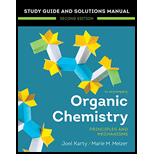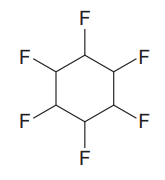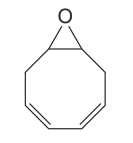
Concept explainers
(a)
Interpretation:
The index of hydrogen deficiency for the given compound is to be determined.
Concept introduction:
The index of hydrogen deficiency of a molecule is the extent to which the molecule is unsaturated. It is half the number of hydrogen atoms missing from the molecule as compared to a completely saturated molecule. The contribution of each double bond in a molecule to the molecule’s index of hydrogen deficiency is 1. The contribution of each triple bond in a molecule to the molecule’s index of hydrogen deficiency is 2. The contribution of each ring in a molecule to the molecule’s index of hydrogen deficiency is 1. If a molecule is saturated and has no rings, double bonds, and triple bonds, its index of hydrogen deficiency is 0.
Answer to Problem 4.47P
The index of hydrogen deficiency for the given compound is zero.
Explanation of Solution
The given compound is

This compound has all single bonds and is a saturated compound. There are no double bonds, triple bonds, or rings in the molecule. Each carbon atom is bonded to four other atoms via single bonds. Thus, the index of hydrogen deficiency for this compound is zero.
The index of hydrogen deficiency for a saturated compound is zero.
(b)
Interpretation:
The index of hydrogen deficiency for the given compound is to be determined.
Concept introduction:
The index of hydrogen deficiency of a molecule is the extent to which the molecule is unsaturated. It is half the number of hydrogen atoms missing from the molecule as compared to a completely saturated molecule. The contribution of each double bond in a molecule to the molecule’s index of hydrogen deficiency is 1. The contribution of each triple bond in a molecule to the molecule’s index of hydrogen deficiency is 2. The contribution of each ring in a molecule to the molecule’s index of hydrogen deficiency is 1. If a molecule is saturated and has no rings, double bonds, and triple bonds, its index of hydrogen deficiency is 0.
Answer to Problem 4.47P
The index of hydrogen deficiency for the given compound is one.
Explanation of Solution
The given compound is

The given compound has one double bond in its structure. Each double bond contributes 1 to the index of hydrogen deficiency. The given structure does not contain triple bonds and rings. Thus, for this compound, the index of hydrogen deficiency is 1.
The index of hydrogen deficiency for an unsaturated compound depends on the number of double bonds, triple bonds, and rings in its structure.
(c)
Interpretation:
The index of hydrogen deficiency for the given compound is to be determined.
Concept introduction:
The index of hydrogen deficiency of a molecule is the extent to which the molecule is unsaturated. It is half the number of hydrogen atoms missing from the molecule as compared to a completely saturated molecule. The contribution of each double bond in a molecule to the molecule’s index of hydrogen deficiency is 1. The contribution of each triple bond in a molecule to the molecule’s index of hydrogen deficiency is 2. The contribution of each ring in a molecule to the molecule’s index of hydrogen deficiency is 1. If a molecule is saturated and has no rings, double bonds, and triple bonds, its index of hydrogen deficiency is 0.
Answer to Problem 4.47P
The index of hydrogen deficiency for the given compound is three.
Explanation of Solution
The given compound is

The given compound has one triple bond in its structure. Each triple bond contributes 2 to the index of hydrogen deficiency. There is one ring in the structure. Each ring contributes 1 to the index of hydrogen deficiency. Thus, for this compound, the index of hydrogen deficiency is
The index of hydrogen deficiency for an unsaturated compound depends on the number of double bonds, triple bonds, and rings in its structure.
(d)
Interpretation:
The index of hydrogen deficiency for the given compound is to be determined.
Concept introduction:
The index of hydrogen deficiency of a molecule is the extent to which the molecule is unsaturated. It is half the number of hydrogen atoms missing from the molecule as compared to a completely saturated molecule. The contribution of each double bond in a molecule to the molecule’s index of hydrogen deficiency is 1. The contribution of each triple bond in a molecule to the molecule’s index of hydrogen deficiency is 2. The contribution of each ring in a molecule to the molecule’s index of hydrogen deficiency is 1. If a molecule is saturated and has no rings, double bonds, and triple bonds, its index of hydrogen deficiency is 0.
Answer to Problem 4.47P
The index of hydrogen deficiency for the given compound is four.
Explanation of Solution
The given compound is

The given compound has one ring in its structure. Each ring contributes 1 to the index of hydrogen deficiency. There are three double bonds in the structure. Each double bond contributes 1 to the index of hydrogen deficiency. Thus, the index of hydrogen deficiency for this compound is
The index of hydrogen deficiency for an unsaturated compound depends on the number of double bonds, triple bonds, and rings in its structure.
(e)
Interpretation:
The index of hydrogen deficiency for the given compound is to be determined.
Concept introduction:
The index of hydrogen deficiency of a molecule is the extent to which the molecule is unsaturated. It is half the number of hydrogen atoms missing from the molecule as compared to a completely saturated molecule. The contribution of each double bond in a molecule to the molecule’s index of hydrogen deficiency is 1. The contribution of each triple bond in a molecule to the molecule’s index of hydrogen deficiency is 2. The contribution of each ring in a molecule to the molecule’s index of hydrogen deficiency is 1. If a molecule is saturated and has no rings, double bonds, and triple bonds, its index of hydrogen deficiency is 0.
Answer to Problem 4.47P
The index of hydrogen deficiency for the given compound is one.
Explanation of Solution
The given compound is

The given compound has one ring in its structure. Each ring contributes 1 to the index of hydrogen deficiency. There are no double bonds and triple bonds in the structure. Thus, the index of hydrogen deficiency for this compound is 1.
The index of hydrogen deficiency for an unsaturated compound depends on the number of double bonds, triple bonds, and rings in its structure.
(f)
Interpretation:
The index of hydrogen deficiency for the given compound is to be determined.
Concept introduction:
The index of hydrogen deficiency of a molecule is the extent to which the molecule is unsaturated. It is half the number of hydrogen atoms missing from the molecule as compared to a completely saturated molecule. The contribution of each double bond in a molecule to the molecule’s index of hydrogen deficiency is 1. The contribution of each triple bond in a molecule to the molecule’s index of hydrogen deficiency is 2. The contribution of each ring in a molecule to the molecule’s index of hydrogen deficiency is 1. If a molecule is saturated and has no rings, double bonds, and triple bonds, its index of hydrogen deficiency is 0.
Answer to Problem 4.47P
The index of hydrogen deficiency for the given compound is four.
Explanation of Solution
The given compound is

The given compound has two rings in its structure. Each ring contributes 1 to the index of hydrogen deficiency. There are two double bonds in the structure. Each double bond contributes 1 to the index of hydrogen deficiency. Thus, the index of hydrogen deficiency for this compound is
The index of hydrogen deficiency for an unsaturated compound depends on the number of double bonds, triple bonds, and rings in its structure.
(g)
Interpretation:
The index of hydrogen deficiency for the given compound is to be determined.
Concept introduction:
The index of hydrogen deficiency of a molecule is the extent to which the molecule is unsaturated. It is half the number of hydrogen atoms missing from the molecule as compared to a completely saturated molecule. The contribution of each double bond in a molecule to the molecule’s index of hydrogen deficiency is 1. The contribution of each triple bond in a molecule to the molecule’s index of hydrogen deficiency is 2. The contribution of each ring in a molecule to the molecule’s index of hydrogen deficiency is 1. If a molecule is saturated and has no rings, double bonds, and triple bonds, its index of hydrogen deficiency is 0.
Answer to Problem 4.47P
The index of hydrogen deficiency for the given compound is five.
Explanation of Solution
The given compound is

The given compound has two rings in its structure. Each ring contributes 1 to the index of hydrogen deficiency. There are three double bonds in the structure. Each double bond contributes 1 to the index of hydrogen deficiency. Thus, the index of hydrogen deficiency for this compound is
The index of hydrogen deficiency for an unsaturated compound depends on the number of double bonds, triple bonds, and rings in its structure.
(h)
Interpretation:
The index of hydrogen deficiency for the given compound is to be determined.
Concept introduction:
The index of hydrogen deficiency of a molecule is the extent to which the molecule is unsaturated. It is half the number of hydrogen atoms missing from the molecule as compared to a completely saturated molecule. The contribution of each double bond in a molecule to the molecule’s index of hydrogen deficiency is 1. The contribution of each triple bond in a molecule to the molecule’s index of hydrogen deficiency is 2. The contribution of each ring in a molecule to the molecule’s index of hydrogen deficiency is 1. If a molecule is saturated and has no rings, double bonds, and triple bonds, its index of hydrogen deficiency is 0.
Answer to Problem 4.47P
The index of hydrogen deficiency for the given compound is five.
Explanation of Solution
The given compound is

The given compound has no rings in its structure. There is one double bond in the structure. Each double bond contributes 1 to the index of hydrogen deficiency. There are two triple bonds in the structure. Each triple bond contributes 2 to the index of hydrogen deficiency. Thus, the index of hydrogen deficiency for this compound is
The index of hydrogen deficiency for an unsaturated compound depends on the number of double bonds, triple bonds, and rings in its structure.
Want to see more full solutions like this?
Chapter 4 Solutions
Organic Chemistry: Principles And Mechanisms: Study Guide/solutions Manual (second)
- H I T H HH H -H C. H- Identify and select all structures below that represent a constitutional isomer(s) of the compound shown above. H- H CIH H H H HHHH H H 0 ·H H– 冊 CH CHI HH C- H- H H- H H A. H H C H H- -H HH H B. H- -H D. H H H H • H -H E. -H H H HICH T HHH F. H-arrow_forwardPolylactic acid (shown below) is a biodegradable polymer used for food packaging. Identify the monomer(s) used in the production of this polymer using a condensation process.arrow_forwardDraw the product of the reaction shown below. Ignore small byproducts that would evaporate pleasearrow_forward
- Poly(ethylene adipate) is a biodegradable polyester (shown below). Identify the type of polymerization process used in the production of this polymer.arrow_forwardPolymers may be composed of thousands of monomers. draw two repeat units(dimer) of the polymer formed in this reaction. assume there are hydrogen atoms on the two ends of the dimer. ignore inorganic byproducts pleasearrow_forwardDraw the product of the reaction shown below. Use a dash or wedge bond to indicate stereochemistry of substituents on asymmetric centers, Ignore inorganic byproductsarrow_forward
- Draw the product of this reaction please. Ignore inorganic byproductsarrow_forwardOne of the pi molecular orbitals of 1,3-butadiene (CH2=CHCH=CH2) is shown below. Please identify the number of nodal planes perpendicular to the bonding axisarrow_forwardDraw the monomers required to synthesize this condensation polymer please.arrow_forward
- Provide the correct systematic name for the compound shown here. Please take into account the keyboard options belowarrow_forwardcurved arrows are used to illustrate the flow of electrons. using the provided starting and product structures, draw the curved electron-pushing arrows for the following reaction or mechanistic step(s)arrow_forwardIdentify the 'cartoon' drawing of the acceptor orbital in the first mechanistic step of an electrophilic addition reaction of butadiene with HBr. Pleasearrow_forward
 Organic Chemistry: A Guided InquiryChemistryISBN:9780618974122Author:Andrei StraumanisPublisher:Cengage Learning
Organic Chemistry: A Guided InquiryChemistryISBN:9780618974122Author:Andrei StraumanisPublisher:Cengage Learning
